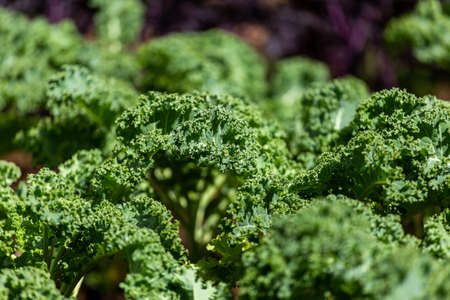1. Introduction to Kale in the British Diet
Kale has a rich history rooted in British soil, making it much more than just a fleeting food trend. Historically, kale was a staple green in cottage gardens across the UK, valued for its hardiness and ability to thrive even during the colder months. During times of rationing in the Second World War, kale earned its place on British tables as part of the “Dig for Victory” campaign, when homegrown vegetables became essential for nutrition and wellness. Fast forward to today, and kale has enjoyed a remarkable revival among modern British households. Its reputation as a superfood—packed with vitamins, minerals, and powerful antioxidants—has cemented its status in everything from comforting soups to vibrant salads and even smoothies. The growing focus on health and wellbeing through diet has made kale an indispensable choice for those looking to nourish their bodies naturally. As we explore the nutritional power of kale and share delicious recipes inspired by local traditions and current research, it becomes clear why this humble leafy green continues to flourish in kitchens across the UK.
2. The Unique Nutritional Profile of Kale
Kale has become a staple in British kitchens, not only for its versatility but also for its remarkable nutritional value. According to recent UK-based research and recommendations from the NHS, kale stands out as one of the most nutrient-dense leafy greens available. It is particularly celebrated for being rich in essential vitamins, minerals, and powerful antioxidants that support overall wellbeing.
Vitamins in Kale
Kale is an excellent source of vitamin K, crucial for bone health and blood clotting. It also offers abundant vitamin C, which supports immune function and collagen formation, alongside significant amounts of vitamin A (as beta-carotene) important for vision and skin health. Below is a summary of key vitamins found in 100g of raw kale:
| Vitamin | Amount per 100g | % UK Adult Daily Reference Intake (RI) |
|---|---|---|
| Vitamin K | 817 mcg | Over 600% |
| Vitamin C | 120 mg | 133% |
| Vitamin A (as beta-carotene) | 9,990 IU | ~200% |
Essential Minerals
Kale contains a variety of minerals important for daily health, especially calcium and magnesium which are vital for strong bones and muscle function. It is also a good plant-based source of iron, supporting energy levels and cognitive performance—a benefit especially appreciated by those following vegetarian or vegan diets in the UK.
| Mineral | Amount per 100g | % UK Adult RI |
|---|---|---|
| Calcium | 150 mg | 19% |
| Magnesium | 47 mg | 13% |
| Iron | 1.5 mg | 11% |
Naturally Potent Antioxidants
Kale’s vibrant green colour signals a high content of protective antioxidants such as lutein and zeaxanthin, which help shield eyes from age-related damage—a fact supported by findings from UK optometry research. Additionally, flavonoids like quercetin and kaempferol have been identified in British-grown kale, offering anti-inflammatory and heart-protective benefits.
The Role of Fibre in Digestive Health
Kale is naturally high in fibre, making it an excellent choice for supporting digestive health—a recommendation echoed by both the NHS and British Dietetic Association. Regular consumption may contribute to balanced gut flora and improved regularity.
A Note on Seasonal Eating in the UK
Nutritional values can vary slightly depending on seasonality and variety grown across the UK. Choosing locally-sourced kale when in season ensures optimal freshness and nutrient retention—a perfect fit for those embracing a natural, wholesome lifestyle.

3. Sourcing and Selecting Fresh Kale in the UK
Kale’s robust flavour and impressive nutritional profile make it a favourite among health-conscious Brits. To enjoy its benefits at their best, sourcing fresh, high-quality kale is key. Across the UK, there are several avenues to explore when searching for top-notch leaves.
Farmers’ Markets: Supporting Local Growers
For the freshest kale, British farmers’ markets are an excellent choice. These vibrant markets—found in cities, towns, and villages alike—often offer organic or sustainably grown kale direct from local farms. Shopping at farmers’ markets not only supports regional agriculture but also means you’re likely to find kale that has been harvested within the past day or two, brimming with vitality and flavour.
Local Greengrocers: Personalised Selection
Your neighbourhood greengrocer can be a wonderful source of fresh kale. Many independent greengrocers prioritise working with nearby growers and can provide helpful advice on what’s in season. Don’t hesitate to ask your greengrocer about the origins of their kale or request tips for preparing it; they often have a wealth of practical knowledge.
Supermarkets: Convenience with Caution
For many, supermarkets offer convenient access to kale year-round. Look for UK-grown varieties where possible, as these tend to be fresher and have travelled shorter distances. Some supermarkets now stock organic options or bagged pre-washed leaves for added ease.
Tips for Choosing the Best Kale Leaves
- Look for crisp, deeply coloured leaves—vivid green or purple, depending on the variety.
- Avoid limp or yellowing leaves, which indicate age or poor storage.
- The stalks should be firm and moist, not dry or brittle.
- If buying pre-packaged kale, check for excess moisture inside the bag, which can hasten spoilage.
Nourishing Choices Begin at the Source
Selecting quality kale isn’t just about taste—it’s about maximising its nutritional impact in your meals. Whether you browse your local market stalls or reach for a supermarket bundle, taking a moment to choose carefully ensures you bring home a leafy green bursting with wholesome goodness.
4. Delicious Kale Recipes for Everyday British Meals
Kale’s versatility makes it a delightful addition to a variety of everyday British meals, whether you’re embracing tradition or exploring modern twists. Here, we share a selection of approachable, health-focused recipes that highlight kale’s nutritional power while celebrating both classic and contemporary British flavours.
Classic British-Inspired Kale Dishes
For those who appreciate the comforting taste of home, kale can be seamlessly incorporated into beloved British classics. These dishes not only nourish but also offer an easy way to boost your daily intake of vitamins and minerals.
Dish |
Description |
Kale Benefits |
|---|---|---|
| Bubble and Squeak with Kale | A hearty pan-fried mix of leftover potatoes, vegetables, and shredded kale for extra green goodness. | Rich in fibre and vitamin C, perfect for supporting immunity. |
| Kale and Stilton Soup | Creamy soup blending earthy kale with tangy Stilton cheese—ideal for chilly evenings. | Provides calcium and antioxidants; pairs well with wholegrain bread. |
| Kale-Infused Shepherd’s Pie | Traditional minced lamb base topped with mashed potato mixed with sautéed kale. | Adds iron and vitamin K for healthy blood and bones. |
Contemporary Favourites Featuring Kale
If you’re seeking lighter, modern options, these recipes embrace the vibrant textures and flavours of kale while keeping nutrition at the forefront:
- Kale & Quinoa Salad: Toss chopped kale with cooked quinoa, roasted sweet potato, toasted seeds, and a drizzle of lemon-tahini dressing for a refreshing lunch or side dish.
- Kale Pesto Pasta: Blend fresh kale with basil, garlic, olive oil, walnuts, and Parmesan to create a nutrient-rich pesto sauce. Stir through wholemeal pasta for a satisfying meal.
- Baked Kale Crisps: Lightly massage kale leaves with olive oil and sea salt before baking until crisp—a wholesome alternative to traditional snacks.
Nutritional Tips for Cooking with Kale
To make the most of kale’s benefits, try lightly steaming or sautéing rather than boiling to retain nutrients. Pairing kale with a source of healthy fat, such as olive oil or avocado, helps your body absorb its fat-soluble vitamins more effectively. Whether folded into breakfast omelettes or sprinkled over a Sunday roast, kale brings both nourishment and a touch of vibrant colour to any British table.
5. Kale and British Wellness Trends
In recent years, kale has become a shining star in the evolving landscape of British wellness culture. Across the UK, there is a growing movement towards mindful eating and nutrition-focused lifestyles, with kale taking centre stage in many popular trends. From vibrant green smoothies sipped on-the-go in London cafés to seasonal supper clubs celebrating locally grown produce, kale is embraced for its versatility and impressive nutritional profile.
The plant-based movement in Britain has seen remarkable growth, with more people adopting vegetarian, vegan, or flexitarian diets for both health and environmental reasons. Kale’s robust texture and earthy flavour make it a perfect ingredient for those seeking hearty, satisfying meals without relying on animal products. Whether tossed into salads, baked into crisps, or stirred into warming stews, kale offers a wealth of options for creative cooks and wellness enthusiasts alike.
Furthermore, wellness influencers and nutritionists across the UK frequently highlight kale’s benefits on social media platforms and in workshops, encouraging followers to incorporate this leafy green into their daily routines. Its role extends beyond individual plates: local markets and farm shops now proudly feature British-grown kale as a seasonal staple, supporting sustainable agriculture and reconnecting communities with homegrown produce.
Kale’s prominence in current British wellness trends reflects a broader shift towards balanced living and conscious food choices. As people become increasingly interested in where their food comes from and how it supports overall wellbeing, kale stands out as an accessible, nutrient-dense option that fits naturally into the nation’s evolving dietary habits.
6. Sustainable Kale: Supporting Local and Seasonal Eating
Embracing kale as part of your diet is not only a boost for your wellbeing, but also a conscious step towards supporting sustainability in the UK. Choosing British-grown kale means you’re championing local farmers and reducing the carbon footprint associated with long-distance food transport. This aligns perfectly with the UK’s seasonal eating ethos, which celebrates enjoying produce at its freshest while respecting the natural rhythm of our countryside.
The Benefits of Local Kale
Opting for locally grown kale ensures that you’re receiving a product harvested at its peak nutritional value. British farms often harvest kale from late autumn through spring, making it an accessible winter green when other vegetables are scarce. This freshness not only enhances taste and texture but also preserves vital nutrients like vitamin C and antioxidants, which can diminish during lengthy transport or storage.
Seasonal Eating: A UK Tradition
Seasonal eating has deep roots in British culture. Historically, communities relied on what was available from nearby fields and gardens, creating a natural rotation of foods throughout the year. Today, this tradition is being revived as more people discover the environmental and health benefits of eating with the seasons. Including kale in your winter stews, salads or sautés is an easy way to honour this practice while making the most of what Britain’s fields have to offer.
Supporting Sustainable Agriculture
By choosing British kale, you’re also encouraging farming methods that protect our landscapes and biodiversity. Many UK growers use crop rotations and integrated pest management to keep soil healthy and reduce chemical inputs. This care for the land helps ensure that future generations will continue to enjoy nutrient-rich vegetables like kale.
In summary, incorporating locally sourced, seasonal kale into your meals is a nourishing choice for both you and the planet. It supports British farmers, reduces food miles, preserves our countryside, and keeps you connected to nature’s rhythms—a true celebration of mindful eating in the UK.

